
Remediation & Restoration
Regulatory
EPA organized the remediation work into three operable units (OUs):
- OU 1 - marsh;
- OU 2- groundwater; and
- OU 3 - upland soils.
Milestones
Cleanup and restoration accomplishments at the site include:
- Most of the plant buildings including the smokestacks have been decommissioned and demolished;
- Approximately 225,000 tons of contaminated soils and materials across more than 40 acres of the land area were excavated and disposed of in approved, off-site landfills;
- Approximately 13 acres of contaminated marsh flats were removed and restored, along with 2,650 feet of tidal channels;
- Comprehensive investigations of soils, sediments, and groundwater are nearly completed and their results will be used to determine whether and what kinds of additional cleanup will be needed at the site;
- Monitoring continues to show improvements in the estuary; based on fish tissue testing, the Georgia DNR fish consumption guidelines were revised in 2018 to allow more frequent eating of some fish caught from the area;
- Treating areas of the groundwater that have high pH impacted by caustic brine.
Marsh
The marsh has significantly improved over the last 30 years, as a result of remediation work done by Honeywell and its partners.
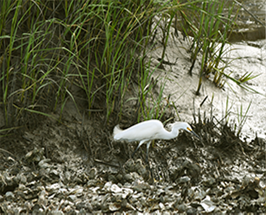
Egret on oyster bed
After an extensive environmental investigation of the tidal marsh adjacent to the former LCP site, the U.S. Environmental Protection Agency (EPA) issued its approval of a cleanup plan in September 2015. The approved remedy, which has now been completed, will reduce risks to human health, mammals, fish and the benthic community.
At the end of 2017 Honeywell voluntarily conducted its third study of fish that live in the waters around the LCP site for the Georgia Dept. of Natural Resources (DNR). Samples of 11 species of fish from Turtle River, Purvis Creek and Gibson Creek were collected and analyzed.
Third-party scientists retained by Honeywell collected fish according to DNR protocols, and sent them to a certified laboratory for analysis. Fish quality of most species has steadily improved since the first fish around the LCP site were studied in 1991 and 1992.
The data help DNR compile its Guidelines for Eating Fish from Georgia Waters.
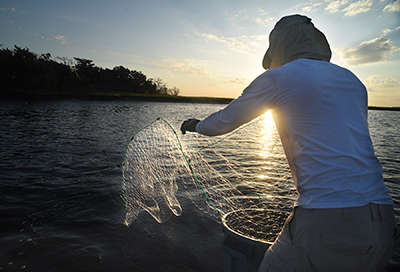 Alex Testoff, an environmental engineer working for Honeywell, nets fish at daybreak on the Turtle River.
Alex Testoff, an environmental engineer working for Honeywell, nets fish at daybreak on the Turtle River.
Investigation, Public Input, and Remediation Honeywell and other parties stepped in and completed cleanup work shortly after LCP Chemicals went bankrupt in 1991 including the excavation, disposal and restoration of approximately 13 acres of contaminated marsh flats and 2,650 feet of tidal channels.
Following the cleanup from 1995-1997, Honeywell and other parties extensively studied the marsh, installing monitoring wells and taking thousands of samples to understand the marsh condition. Honeywell also worked under the direction of the regulators, EPA and the Georgia Environmental Protection Division (EPD) to complete ecological and human health risk assessments.
The remedy included:
- Dredging the higher concentration sediment from the creeks;
- Covering the lowest concentration material in the marsh flats; and
- Implementing a robust long-term monitoring program.
The cleanup plan reflects years of scientific investigations and engineering analyses.
Honeywell is committed to remediating and restoring the marsh and returning the LCP site to productive use that will benefit the Brunswick economy.
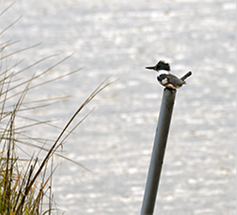
Belted Kingfisher
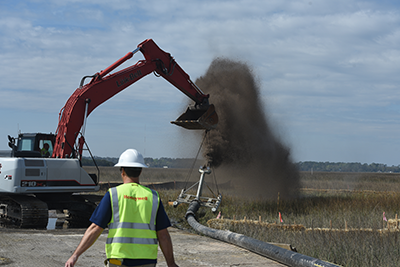
Thin cover application
The EPA remedy, specified in a consent decree between EPA, Honeywell, and Georgia Power, used a combination of technologies: dredging and a thin layer cover. The thin layer cover was determined to represent the best option for portions of the marsh that were relatively less contaminated and subject to low levels of erosion.
A pilot study provided data to advance the design of the full-scale remedy and enabled contractors to develop effective techniques to minimize disruption to the marsh.

Sediment sampling
Groundwater
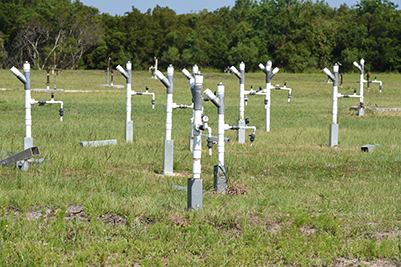
A system of sparging wells treated the groundwater successfully.
More than 150 groundwater monitoring wells check the movement and conditions of groundwater beneath the site. Data are collected and analyzed from an upland area that housed a variety of manufacturing facilities over 75 years.
An important milestone was reached in 2016 with the completion of an initial carbon dioxide (CO2) treatment of an extensive area within the footprint of an old manufacturing building impacted by caustic brine. Honeywell utilized an innovative treatment technology, injecting or "sparging" CO2 into the sub-surface to reduce the levels of pH (alkaline) and mercury.
The CO2 treatment occurred in three phases over several years, and deployed 209 sparging wells. The pH reduction and mercury stabilization are permanent and not changed by natural conditions such as storms or flooding.
In 2019, the fourth phase of the CO2 was initiated, in the former cell building process area.
Testing over time has demonstrated that local drinking water supplies are not affected by the site groundwater.
Honeywell has been investigating and compiling data on the OU2 (groundwater) area, as the next step toward preparing the remedial investigation/feasibility study.
Upland soils
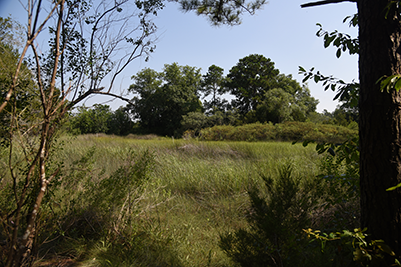
The upland soils area of the site (OU3) was initially addressed through a massive excavation in the 1990s. Honeywell and several other parties spent more than $50 million cleaning up the soil during this time. Approximately 225,000 tons (about 15,000 truckloads) of contaminated soils were taken offsite and back-filled with clean soil.
In 2019, the EPA recommended a remedy for OU3 that would require monitoring and a deed restriction that would ensure the property would always be used for non-residential use. The "no further action" recommendation reflects the results of extensive clean-up work and is supported by the data in the human health and ecological risk assessments. EPA determined that no additional upland soil remediation was necessary in September 2020.
The uplands portion of the site is ready for industrial re-use now based on the extensive soil removal conducted in past years. Approximately 30 acres of the uplands area have already been redeveloped by Glynn County.
